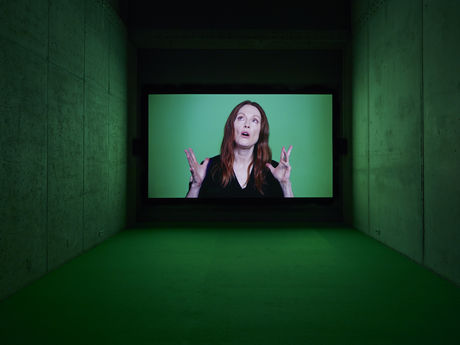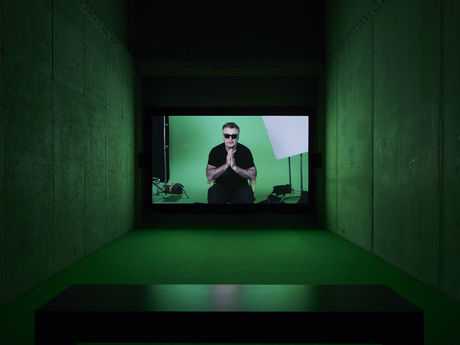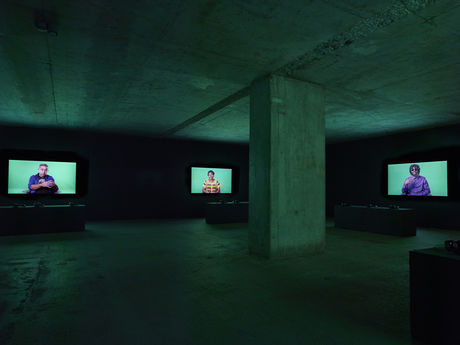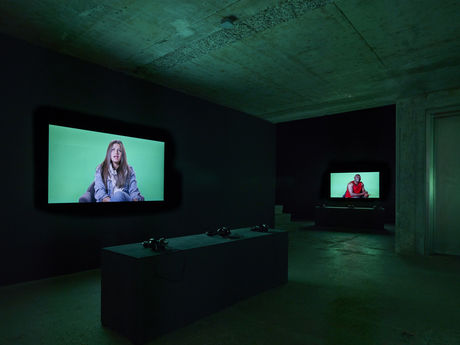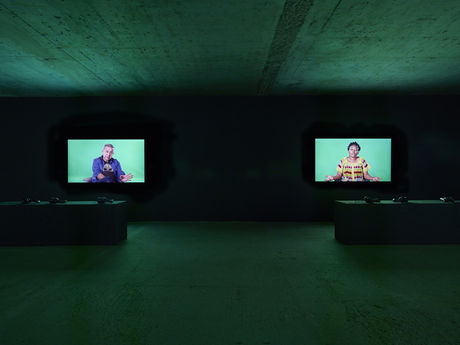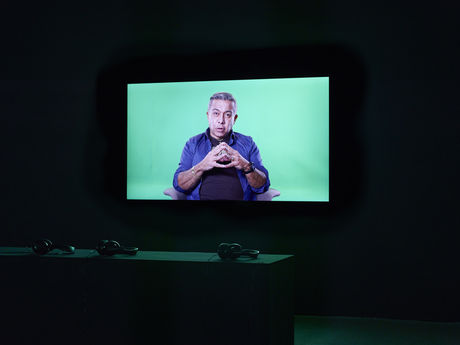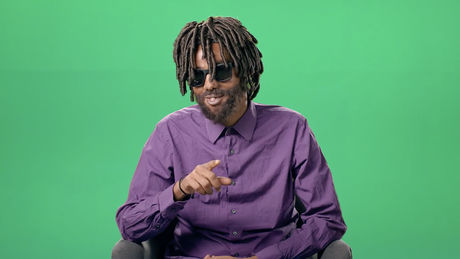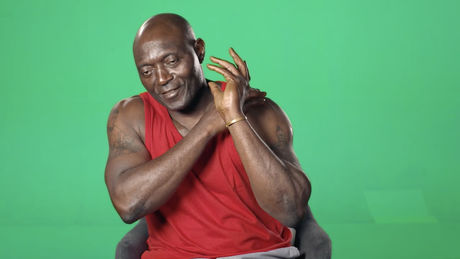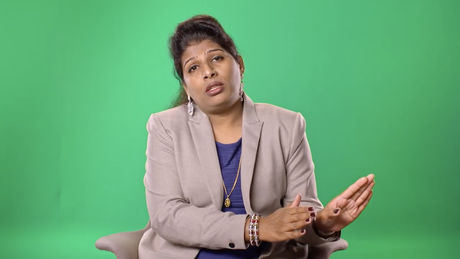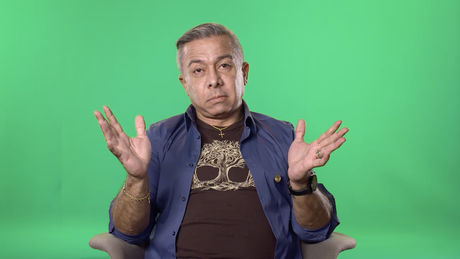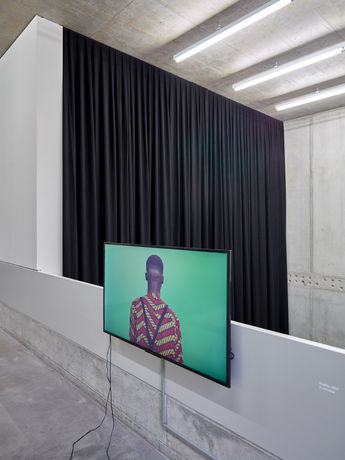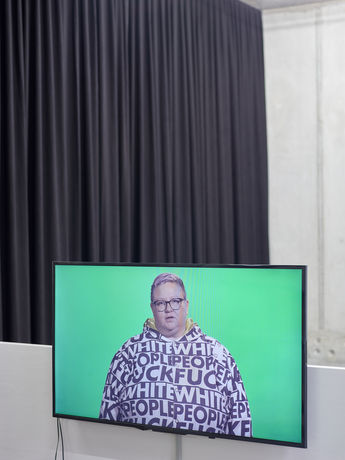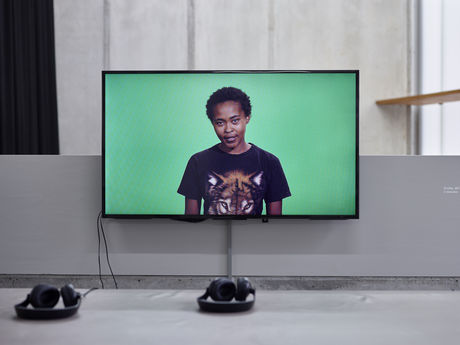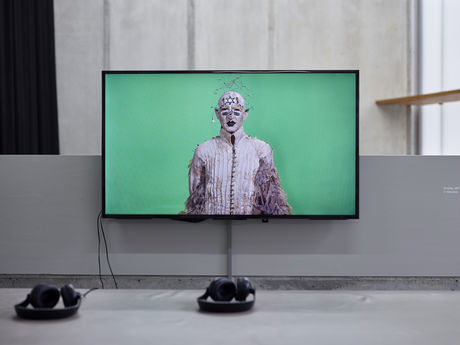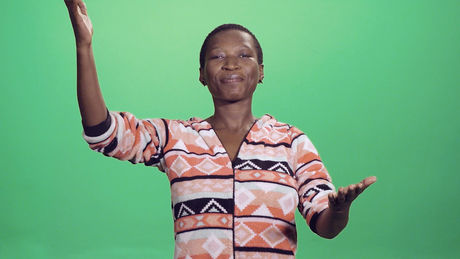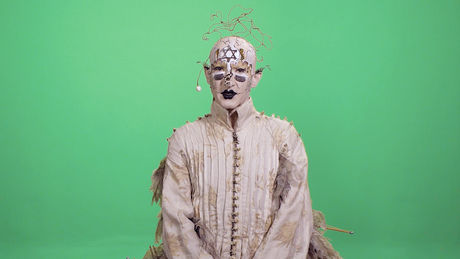Apr 29 – Jul 30, 2017
“Alec, you’re famous! People will listen to you,” says Alec Baldwin to himself, a few moments before sharing the details of his arrest in Cairo, his journey to Italy on a desperately overcrowded fishing boat, and his eventual arrival in the unfamiliar city of Berlin on a rainy day in September 2015. Cut. Julianne Moore briefly fixes her hair. And then recounts the brutal attack that she and her children survived back home, shattering what had been a comfortable life in the Democratic Republic of the Congo, and leaving her with no choice but to smuggle herself and her children – via an endless journey in the back of a windowless truck – towards an uncertain future in an unknown country. In our first encounter with Love Story, Moore and Baldwin address us via a large projection, to speak of past anguish and hope for the future, of forced migration and loss, but also of the comfort of safety, friendship and love. They send shivers down our spines. We feel for them and with them, although the experiences that they articulate are obviously not their own and – for the most part – unlikely to be ours. Such is the power of cinema. Who would deny its ability to create illusion?
Yet these narratives of escape and of fresh beginning are hardly delivered to us seamlessly. Breitz has recruited two familiar faces – two members of the global media family that we’re accustomed to welcoming into our living rooms – only to put into their mouths the stories of people who are generally treated as faceless and voiceless in our culture, only so as to introduce us to those who are typically destined to remain outside and beyond our zones of comfort: isolated in refugee camps and asylum courtrooms, relegated to the basement of our social (un)conscious. Over the course of seventy-three minutes, the montage featuring Baldwin and Moore suspends us between cinema-at-its-best – a dramatized narration that moves us to tears and to laughter; and the inevitably awkward spectacle that ensues as we observe two highly-privileged celebrities attempting to earnestly channel lives that could not be more remote from their own. We are alternately moved and utterly perturbed. What business do major stars of the hegemonic American storytelling industry – with their iconic onscreen presence and professionally polished delivery – have slipping into these roles?
Alec Baldwin as a former child soldier from Angola? Julianne Moore as a refugee from war-torn Syria? The irreconcilable gap between these famous faces and the stories of displacement that they endeavour to embody on the screen before us, is reiterated formally by Breitz’s edit, which moves us at whiplash-pace between Baldwin and Moore, weaving a series of narrative fragments into a cinematic composition that in turn invites empathy and critique, credulity and disbelief. Captured in the nondescript vacuum of a green-screen set and denied the usual tricks of the trade (the actors wear their own clothes and perform without backdrops, accents or props), these two white bodies are exemplary of the exceptionalism that neoliberalism holds so dear. As they seek to animate the invisible lives of others, we cannot help but read the actors as privileged representatives of a broader economy of subjectivity, an economy in which an exclusive handful of individuals monopolises the precious currency of our attention, bathing in the visibility that we lavish on them as others are left to linger in the shadows of obscurity, their vague contours condemning them to anonymity. But there is still more of Love Story to be seen.
Descending into KOW’s subterranean gallery, we come face-to-face with six men and women, whom Breitz interviewed in Berlin, New York and Cape Town in late 2015. The script for the Hollywood montage was in fact compiled from excerpts drawn from these interviews, which Breitz now presents to us in their full complexity and duration on six large monitors. These are the faces and the lives behind the fictional montage. The dramatic intensity of our initial encounter with the work gives way to sobriety, curiosity and insight, as the interviewees articulate their lived experience, sharing memories and anecdotes against a now familiar green screen. “People don't even care about us, you know, they would never put us on a movie screen and talk about us,” says Mamy Maloba Langa, who fled the horrific violence that was inflicted on her in Kinshasa: “The media is only interested in famous people; I don’t think all those nice people would come just to listen to my story, I don’t think so…”. José Maria João, who – as a child soldier – spent years following the murderous commands of generals (before finally fleeing Angola for the relative safety of Namibia), has a strong message for Baldwin: “Alec, you must be happy that Candice is giving you this opportunity to give people my story, to tell them about my life. I just want to ask you to tell this story that I went through in the right way. You must get it right.” João is issuing an assignment to the Hollywood actor. Some kind of collaboration is in the works.
Breitz has in fact built a bridge over which six refugees – standing in for millions of others – have been invited to step into public view. “Some of the most pressing social issues of our times have come into the limelight only after Hollywood actors and actresses performed certain roles,” explains Shabeena Saveri, a transgender activist who was forced to leave India under severe duress. Saveri is aware of the visibility that is afforded to blockbuster cinema and contemporary art. She sets out to harness this visibility, threading her own words – as a ventriloquist might – through the body of Julianne Moore. Moore rises to the task dutifully: “I was thinking, and I put myself in the shoes of that Hollywood actress, and I was thinking that if I were her, then this story would make a huge impact, because then it would reach a much larger audience….” Saveri’s sentiments are echoed elsewhere by Luis Nava, a respected Venezuelan professor and political dissident who fled Caracas, and now lives in exile in New York; Farah Mohamed, a young atheist whose lack of religious conviction put his life at risk back in Somalia; and Sarah Mardini, who left Syria in 2015 along with her younger sister Yusra (Yusra’s participation in the Olympic Games in Rio in 2016, perhaps inevitably, attracted bids from Hollywood to turn her life story into a movie).
Each of these six stories is singular. Each demands to be heard. And each intersects with thousands of similar stories. The world is full of such stories. Who can listen to them all? Love Story asks this question pointedly, putting forward six first-person accounts that collectively amount to twenty-two hours of footage. Sooner or later, we are overwhelmed by the duration. We wander back to the condensed summary offered by Moore and Baldwin. Or we head home. Or we go to the movies. The great show trumps the truth. In an age in which cat videos and Trump’s tweets vie with stories of humanitarian disaster to capture our short spans of attention, an age in which late-night comedy has become a primary news source for so many, it is futile to insist on distinctions between fake and real news, between lived experience and fiction, between events and their representation. Instead, Breitz hacks into the operating system of the neoliberal attention economy, hoping to re-direct the flow of our attention, seeking to interrogate our capacity for solidarity.
Breitz’s montage exposes the mechanisms by means of which mainstream entertainment manipulates us emotionally, drilling into our affective being, choreographing our empathy and our relationship to community via the cult of celebrity and the disavowal of narrative complexity; a relentless combination of technology, aesthetics and performative prowess. The manipulative potential inherent in popular form is perhaps best understood, in the current political climate, by those on the right. Propaganda is hardest to dismantle and critique when it appeals to us at the level of emotion, rather than by reasoning with us. Love Story both reflects and reflects on the rampant populism of our time. The work caters to the same affective mechanisms, all the while purposefully stripping them bare; deconstructing them in order to take a clear stance against right-wing populism.
Does Love Story succeed in carving out a form of solidarity? Does the work spark passionate concern for the plight of others in a language that might be understood by many? The work is neither able (nor does it pretend) to resolve the ethical dilemma that is at the core of our fast-moving digital culture: Most of us simply don’t have the time, attention or patience that is required to hear out the very voices that can grant us an understanding of today’s economic and political cruelties. So, we surrender ourselves to the oblivion that allows such cruelties to be perpetuated. Over the past twenty-five years, Breitz’s oeuvre has scrutinised the manner in which neoliberal logic shapes and defines the experience of subjectivity, questioning the degree to which this logic might be evaded. In presenting a dense archive of marginal voices in counterpoint to an easily accessible and digestible fiction that appropriates and dramatizes these voices, Love Story urges us to interrogate the conditions under which we are able (and willing) to exercise empathy.
Breitz suggests that the end of universal narratives does not necessarily imply the failure of far-reaching instruments of communication. There’s something to be gained when we trade a longing for truth and authenticity for the hope that new modes of storytelling can be found and disseminated, stories that might make people whom we wouldn’t willingly invite into our living rooms seem familiar enough so that we might want to change our minds. At the same time, Breitz demonstrates how readily over-simplified narratives can be instrumentalised, first to bolster illusion and then to serve ignorance. Luminous with the artist’s keen intelligence, the exhibition at KOW offers us emancipatory pleasure that is tinged with the bitter insight that we may not overcome the barrier between ourselves and those values which we hold to be morally just. Failing to put our convictions into practice may effectively signal our contribution to the diminishment of others’ prospects in life.
Love Story was commissioned by the National Gallery of Victoria (Melbourne), Outset Germany and Medienboard Berlin-Brandenburg. It was first shown at the Kunstmuseum Stuttgart in 2016, accompanied by a publication at Kerber Verlag.
PROFILE
Featuring Igshaan Adams, Roger Ballen, Steven Cohen, Gabrielle Goliath, Dean Hutton, Banele Khoza, Gerald Machona, Buhlebezwe Siwani, Chuma Sopotela and Sue Williamson
Who speaks in the name of whom? In 2017, Candice Breitz will represent her country of birth at the 57th Venice Biennale – South Africa, a country in which the question of who may (or may not) legitimately occupy the space of representation, is particularly fraught. Recently, debates around the extent to which white South Africans can engage, portray or stand in alliance with black South Africans, have been amplified against the backdrop of a global right-wing backlash that seeks to reverse social justice gains. Can would-be allies whose very being is defined by socio-historical privilege, avoid simply entrenching such privilege as they endeavour to align themselves with communities who have been denied this privilege? Such questions lie both at the heart of Breitz’s Love Story, and at the core of Profile, a new work that responds to Breitz’s nomination as one of two artists who will represent South Africa in Venice this year (her work will appear alongside that of compatriot Mohau Modisakeng).
In Profile, a work that was conceived and shot in Cape Town in early 2017, Breitz absents herself from visibility before the camera, instead platforming ten prominent South African artists who might equally have been nominated to represent the country. As their collective appearance usurps Breitz’s presence, the implied self-portrait gives way to a polyphonic riff, imploding the very assumptions that conventionally guarantee the genre of portraiture. “My name is Candice Breitz,” the cast of voices insists intermittently, punctuating descriptions of who those before the camera are (or might be): man or woman, white or black, working or middle class…. Veering erratically between descriptors of race, class and gender, occupation and national belonging, the verbal palate of attributes and markers delivered by the artists varies wildly in credibility. Who is here as a self and who is here as an other?
“I’m Candice Breitz, and I approve this message,” the multi-voiced litany concludes, parodying the sentence that American presidential candidates are legally obliged to use as rhetorical authentication of their campaign ads during an electoral cycle. In the context of Profile, however, the sentence subverts the proof of authenticity it is supposed to furnish. Blurring the genre of self-portraiture with the formal language of electoral politicking and self-promotional branding, Profile re-distributes the heightened attention typically garnered by an artist due to a Venice appearance, to a range of fellow artists who – much like Breitz – appear intent on consciously disrupting any fixed notion of subjectivity. Dodging objectification, the artists featured in Profile confront the placatory ‘rainbow nation’ metaphor that is too readily applied to post-apartheid South Africa, with the country’s lived reality. In so doing, they extricate the question of who may legitimately speak for their nation in Venice from the regime of representation to prompt a debate around who should be able to speak in a discussion of the many who may not actually be the subjects when they are being spoken for and about in Venice.
Profile was commissioned by the South African Pavilion on the occasion of the 57th edition of the Venice Biennale, with the support of the South African Department of Arts and Culture and Connect Channel.
Reviews:
gallerytalk (by Eva Beck, June 28, 2017)
Hyperallergic (by Dorian Batycka, June 15, 2017)
AGNB (by Angels Miralda, June 12, 2017)
frieze (by Ben Ferguson, June 7, 2017)
TAGESSPIEGEL (by Claudia Wahjudi, April 28, 2017)

